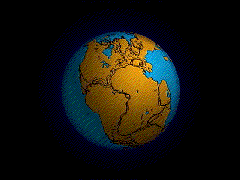Pangea

Pangea was a supercontinent that existed from about 300 to 200 million years ago. It included most of the continental crust of the Earth. Pangea formed during the late Paleozoic Era when several smaller continents collided, welding together to form a single supercontinent. It was surrounded by Pantalassa, the ancestral Pacific. Pangaea was first written about by Alfred Wegener in his theory of continental drift.
Under plate tectonic action, Pangea split up to form Laurasia in the north and Gondwanaland in the southern hemisphere. In turn these, too, split up to form our modern continents.
The animation shown here begins early in the Mesozoic Era, during the Triassic Period, and shows the motion of the continents to their present positions.


